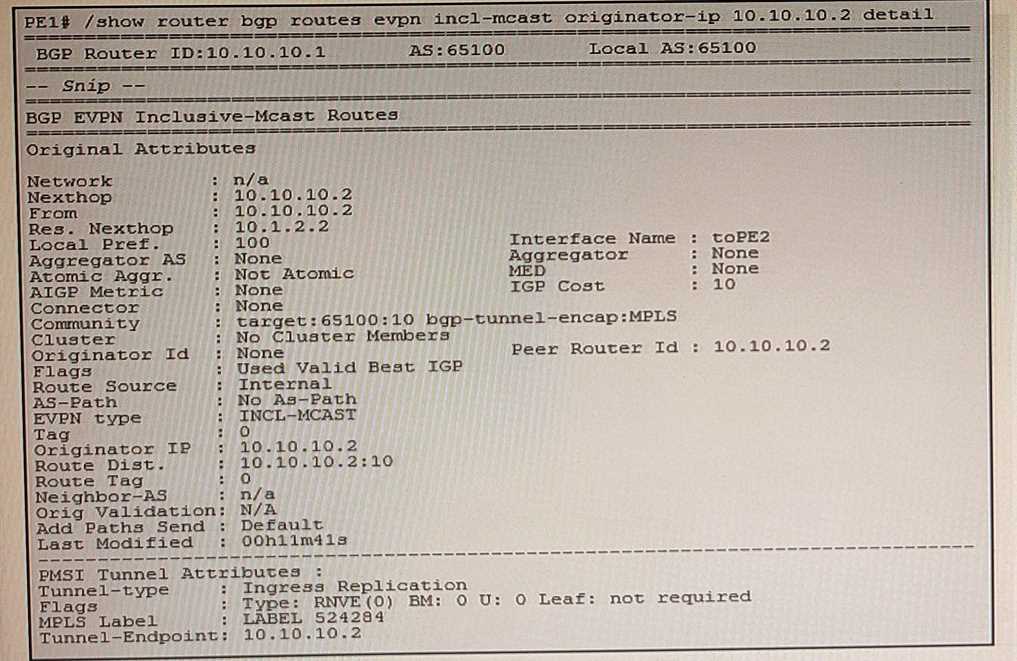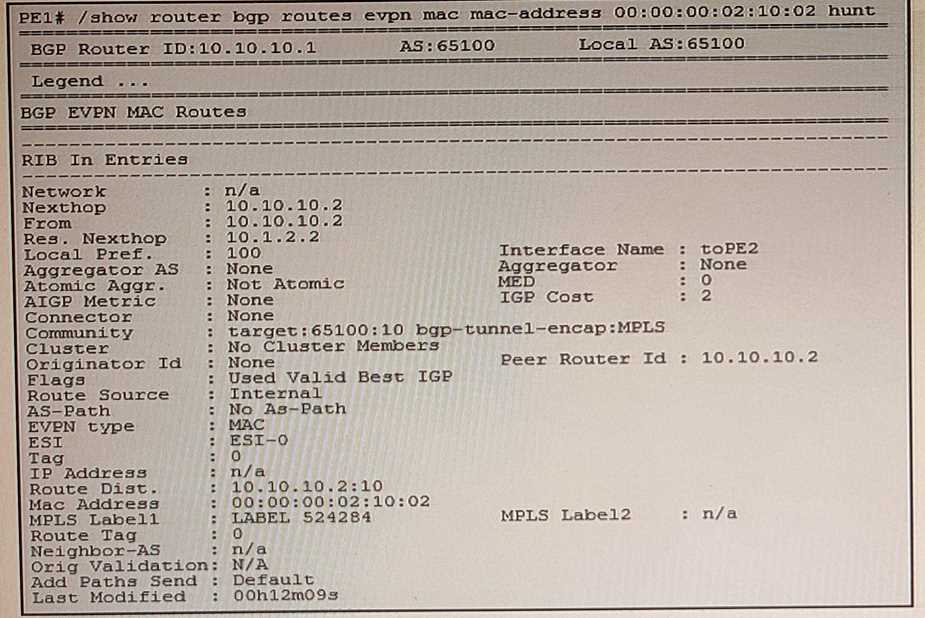nokia 4a0-115 practice test
Nokia Ethernet Virtual Private Network Services
Question 1
Which of the following statements about the EVPN data plane is FALSE?
- A. EVPN allows a service provider to deliver multiple services over a single core network.
- B. The customer data is encapsulated and then tunneled between the PE routers.
- C. EVPN-MPLS encapsulated data has a label that uniquely identifies each service.
- D. EVPN-MPLS provides services over a simple IP network.
Answer:
D
Explanation:
EVPN-MPLS provides services over an MPLS network, not a simple IP network.
The customer data is
encapsulated with an MPLS label that identifies the service and then tunneled between the PE
routers using MPLS LSPs1
.
Verified Reference:
Ethernet Virtual Private Networks (EVPNs)
Question 2
Based upon the exhibit, how many MAC-VRFs are there?
- A. 1
- B. 2
- C. 3
- D. 4
Answer:
B
Explanation:
There are two MAC-VRFs in the exhibit, one for each EVI.
A MAC-VRF is a logical entity that contains
the MAC forwarding information for a given EVI1
.
Verified Reference:
Ethernet Virtual Private Networks (EVPNs)
Question 3
Which of the following statements about multi-homing for a Layer-2 service is TRUE?
- A. In the single-active mode, the CE requires a LAG to be configured between the CE and all attached PEs.
- B. In the single-active mode, the CE forwards traffic to all attached PES and receives traffic from a single PE.
- C. In the all-active mode, all PES attached to a CE can forward traffic to and from the CE.
- D. The Nokia 7750 SR supports a CE being multi-homed to a maximum of two PEs.
Answer:
C
Explanation:
In the all-active mode, all PEs attached to a CE can forward traffic to and from the CE. This provides
load balancing and redundancy for the CE.
The CE does not require a LAG to be configured between
the CE and all attached PEs1
.
Verified Reference:
Ethernet Virtual Private Networks (EVPNs)
Question 4
Which of the following statements about PE-to-PE MAC address advertisement is FALSE?
- A. The service distinguisher (label or VNI) is advertised with the MAC/IP EVPN update.
- B. Route targets are used to uniquely identify routes between EVIS in the case of MAC address overlaps.
- C. A PE uses a single MP-BGP session with a remote peer to exchange the routes for all EVIs.
- D. A PE advertises locally-learned MAC addresses to remote PES using EVPN type-2 routes.
Answer:
B
Explanation:
Route targets are not used to uniquely identify routes between EVIs in the case of MAC address
overlaps. Route targets are used to control the import and export of routes between different EVIs or
VRFs.
The service distinguisher (label or VNI) is used to uniquely identify each service1
.
Verified Reference:
Ethernet Virtual Private Networks (EVPNs)
Question 5
Which of the following statements about EVPN Layer-3 services that utilize the interface-ful model is
TRUE?
- A. EVPN MAC/IP routes are used to advertise the IP prefixes of subnets attached to a VPRN.
- B. VPRN instances are interconnected using a supplementary broadcast domain (SBD) VPLS.
- C. Intra-subnet traffic is carried over the tunnels provided by the SBD VPLS.
- D. The MAC/IP routing information is used to populate the VPRN routing table at the remote PEs.
Answer:
C
Explanation:
In the interface-ful model, VPRN instances are interconnected using a supplementary broadcast
domain (SBD) VPLS. Intra-subnet traffic is carried over the tunnels provided by the SBD VPLS.
The
MAC/IP routing information is not used to populate the VPRN routing table at the remote PEs, but
rather to populate the FDB of the SBD VPLS2
.
Verified Reference:
Nokia Ethernet Virtual Private Network Services Course | Nokia
Question 6
Based upon the exhibit,
which of the following statements about the forwarding of BUM traffic is FALSE?
- A. PE3 replicates the traffic and sends it to all PES in its VPLS I flooding list.
- B. PE3 adds an ESI label to packets forwarded to PEI because PEI is connected to the same Ethernet segment.
- C. PEI forwards the traffic received from PE3 to CEI, and CEI discards it based upon the ESI label.
- D. PE2 decapsulates the packets received from PE3 and forwards the frames to CE2.
Answer:
B
Explanation:
PE3 does not add an ESI label to packets forwarded to PE1 because PE1 is connected to the same
Ethernet segment.
PE3 adds an ESI label only to packets forwarded to PEs that are not connected to
the same Ethernet segment, such as PE21
.
Verified Reference:
Ethernet Virtual Private Networks (EVPNs)
Question 7
In the exhibit,
MACI moves from PEI to PE2. Which of the following actions related to this MAC address mobility is
performed?
- A. CEI generates an update message to PEI withdrawing its MAC.
- B. PEI generates an update message to remote PES identifying the new location of CEI.
- C. PE2 advertises a MAC/IP route for MACI with a sequence number higher than that received from PEI.
- D. PE3 waits to receive a data packet from CEI to update its FDB entry for MACI.
Answer:
C
Explanation:
PE2 advertises a MAC/IP route for MAC1 with a sequence number higher than that received from
PE1. This indicates that MAC1 has moved from PE1 to PE2 and triggers a MAC withdrawal message
from PE1 to remote PEs.
CE1 does not generate an update message to PE1 withdrawing its MAC, nor
does PE1 generate an update message to remote PEs identifying the new location of CE11
.
Verified Reference:
Ethernet Virtual Private Networks (EVPNs)
Question 8
What are EVPN inclusive multicast Ethernet tag (IMET) routes used for?
- A. To advertise the MAC or MAC/IP addresses of locally-learned hosts
- B. To advertise the redundancy mode of a local Ethernet segment
- C. To discover all PES participating in the same VPIS service
- D. To discover all PES attached to the same Ethernet segment
Answer:
C
Explanation:
EVPN inclusive multicast Ethernet tag (IMET) routes are used to discover all PEs participating in the
same VPIS service. These routes are also used to build the flooding list for BUM traffic.
Question 9
Based on the exhibit below, which of the following statements is FALSE?
When forwarding BUM traffic, the local PE must replicate the traffic and send it as unicast to the
advertising neighbor.
- A. The MPLS label 524284 presented indicates the service label value that the neighbor 10.10.10.2 uses to forward BUM traffic to PEI.
- B. When forwarding BUM traffic, the local PE uses an MPLS transport tunnel towards the advertising neighbor.
- C. The IMET route is imported by a local VPLS configured with a route-target value of 65100:10.
Answer:
A
Explanation:
When forwarding BUM traffic, the local PE does not replicate the traffic and send it as unicast to the
advertising neighbor. Instead, the local PE uses an MPLS transport tunnel towards the advertising
neighbor and sends the traffic with an MPLS label that indicates the service.
Question 10
Based on the exhibit below, which of the following statements is TRUE?
- A. PE2 advertises this BGP update for a locally-configured VPWS service.
- B. PEI uses this BGP update to build the flooding list of the associated service.
- C. PEI uses MPLS label 524284 when sending traffic destined to
- D. Neighbor 10.10.10.2 is connected to a multi-homed CE.
Answer:
B
Explanation:
PE1 uses this BGP update to build the flooding list of the associated service. The update contains an
IMET route that indicates that neighbor 10.10.10.2 is participating in a VPLS service with a network
identifier of 10.
Question 11
Based upon the exhibit, which of the following statements is FALSE?
- A. PEI populates this information into the local VPLS FDB.
- B. Neighbors 10.10.10.2 and 10.10.10.3 have proxy-ARP enabled for the VPLS.
- C. Neighbors 10.10.10.2 and 10.10.10.3 have a service that uses a network identifier of 10.
- D. PEI uses VXLAN tunnels to reach neighbors 10.10.10.2 and 10.10.10.3.
Answer:
D
Explanation:
PE1 does not use VXLAN tunnels to reach neighbors 10.10.10.2 and 10.10.10.3. PE1 uses MPLS
tunnels to reach these neighbors, as indicated by the MPLS label values in the output.
Question 12
None
- A. Proxy-ARP/ND is operational for a VPLS. Which of the following statements is FALSE?
- B. The PE has proxy-ARP and dynamic-populate enabled for the VPLS.
- C. The proxy-ARP table is populated by snooping IP packets received from remote PEs.
- D. When the PE learns a local host IP address, it adds an entry into its proxy-ARP table.
- E. The PE advertises a MAC/IP route that includes the MAC and IP address of a local host.
Answer:
C
Explanation:
When the PE learns a local host IP address, it does not add an entry into its proxy-ARP table. The
proxy-ARP table is populated by snooping IP packets received from remote PEs. The PE advertises a
MAC/IP route that includes the MAC and IP address of a local host.
Question 13
Based upon the exhibit, which of the following statements is FALSE?
- A. VPLS 10 must be configured with two BGP instances on PE3 and PE4.
- B. On PE3 and PE4, VPLS 10 must be configured with two different route-distinguisher values: one for VXLAN and another for MPLS.
- C. On PE3 and PE4, VPLS 10 must be configured with two different route-target values: one for VXLAN and another for MPLS.
- D. A BGP export policy is required on PE3 and PE4 to ensure that IMET routes originated with VXLAN encapsulation are not advertised to the peer across the core network.
Answer:
A
Explanation:
VPLS 10 does not need to be configured with two BGP instances on PE3 and PE4. VPLS 10 can be
configured with a single BGP instance that supports both VXLAN and MPLS encapsulations.
Question 14
Which of the following statements about an EVPN with integrated routing and bridging (EVPN-IRB)
service is FALSE?
- A. This service requires the use of EVPN-MPLS for data plane.
- B. In this service, the IRB interface acts as a default gateway for hosts in the corresponding subnet.
- C. This service consists of a VPRN and multiple VPLSs.
- D. This service enables the use of EVPN to provide connectivity between hosts in different subnets.
Answer:
A
Explanation:
EVPN with integrated routing and bridging (EVPN-IRB) service does not require the use of EVPN-
MPLS for data plane. EVPN-IRB service can use either EVPN-MPLS or EVPN-VXLAN for data plane.
Question 15
Which of the following statements does NOT describe the operation of the Layer-3 EVPN asymmetric
forwarding model?
- A. All VPLS instances must be configured on all PES regardless of whether they have a local host or not.
- B. EVPN IP-Prefix routes are used to populate the VPRN VRF tables.
- C. The egress PE does not perform any Layer-3 route look up to forward traffic.
- D. The ingress PE performs both Layer-2 and Layer-3 look ups when forwarding traffic between subnets.
Answer:
A
Explanation:
All VPLS instances do not need to be configured on all PEs regardless of whether they have a local
host or not. Only the VPRN instance needs to be configured on all PEs, while the VPLS instances are
configured only on PEs that have a local host attached to them.